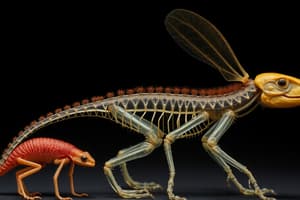Podcast
Questions and Answers
Which characteristic of Eukarya indicates that it lacks peptidoglycan?
Which characteristic of Eukarya indicates that it lacks peptidoglycan?
- Animalia Characteristics
- Characteristic #1 (correct)
- Fungi Characteristics
- Characteristic #2
What is the second characteristic of Eukarya?
What is the second characteristic of Eukarya?
Has nucleus and organelles
Animalia are unicellular and autotrophs.
Animalia are unicellular and autotrophs.
False (B)
What are the characteristics of Plantae?
What are the characteristics of Plantae?
What are the characteristics of Fungi?
What are the characteristics of Fungi?
What are the characteristics of Protista?
What are the characteristics of Protista?
Flashcards are hidden until you start studying
Study Notes
Eukarya Characteristics
- Eukarya does not contain peptidoglycan, differentiating it from prokaryotic organisms.
- Eukaryotic cells possess a defined nucleus and specialized organelles, allowing for complex cellular functions.
Animalia Characteristics
- Members of the Animalia kingdom are multicellular organisms.
- All Animalia species are heterotrophs, meaning they obtain nutrients by consuming other organisms.
Plantae Characteristics
- Plantae are multicellular organisms primarily classified as autotrophs, capable of photosynthesis.
- They possess cell walls made of cellulose, providing structural support.
Fungi Characteristics
- Fungi are generally multicellular and classified as heterotrophs, absorbing nutrients from their surroundings.
- Their cell walls are made of chitin, which differs from the composition found in plants.
Protista Characteristics
- Protista includes both multicellular and unicellular organisms, showcasing diversity within the group.
- Nutritional modes vary among protists, with some acting as heterotrophs and others as autotrophs.
Studying That Suits You
Use AI to generate personalized quizzes and flashcards to suit your learning preferences.




